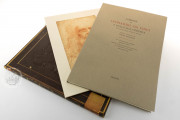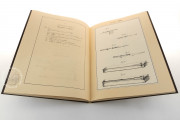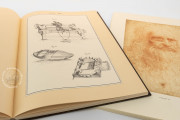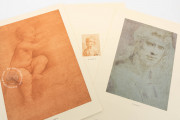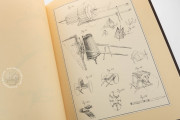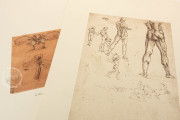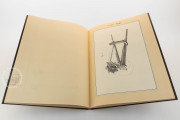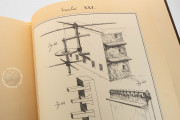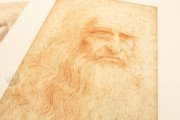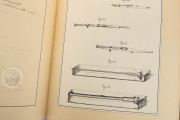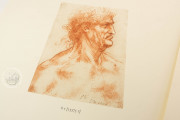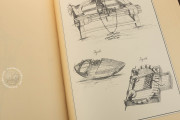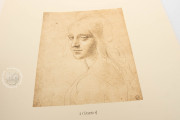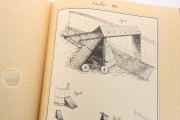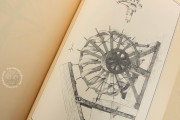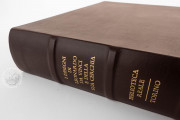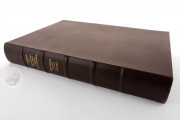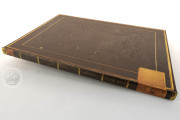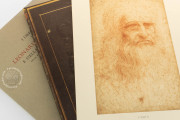This collection includes the reproduction of twenty-three drawings by Leonardo da Vinci and his circle housed in the Biblioteca Reale of Turin. The compilation of drawings in the Biblioteca Reale di Torino has retained its original composition dating back to Giovanni Volpato of Riva di Chieri (1797-1871), the Piedmontese collector who formed it during his stays in France and England, and from whom it was purchased en bloc by Carlo Alberto of Savoy around 1840.
Unfortunately, there is no way to ascertain the older provenance of the individual drawings, except for the one of insects, which in the eighteenth century was found in the Reynolds and Richardson Sr. collections in England.
Leonardesque Autographs
The autograph drawings that make up the Turin collection each find a chronological placement in a set that comes to represent the most salient phases of Leonardo's activity, from his youthful years to those of maturity.
1. Self-portrait (ca. 1515-16)
The drawing that rightly occupies the first place in the Turin collection is Leonardo's famous self-portrait. The head, with a broad forehead and with long hair and a long beard, is seen three-quarters to the right, a shoulder and part of the torso hinted at on the left. On the right, the shoulder is just indicated. Leonardo's physical appearance is revealed in the image of Turin: the broad forehead marked by wrinkles, the aquiline nose, the mouth with the protruding lower lip, the marked chin. This drawing is characterized by an extraordinary expressive power to which the very format of the paper, larger than that of any other portrait drawn by Leonardo, contributes.
Like other famous works of Leonardo, the self-portrait has been the subject of countless and varied interpretations that have helped to fuel its myth. The intended meaning behind the self-portrait in Turin remains elusive, beyond the rather evident idea that Leonardo himself had of painting as the only means to overcome the inexorable process of time and to transmit to posterity the memory of his physical appearance.
2. Portrait of a young girl, presumed study for the angel of the Virgin of the Rocks (ca. 1483-5)
There is no doubt that the most famous drawing of the Turin collection, after the self-portrait, is the study for the angel of the Virgin of the Rocks. The drawing is a reflection of what Leonardo had learned from his sculptor master, Verrocchio, on how to practice portraying a figure in the mobility of its attitudes, capturing it from the various points of view offered by walking around it.
The bust of the young woman is seen three-quarters from the back, the curve of the breast indicated on the left and the head turned to the viewer, but with the gaze directed slightly to the right in an absorbed expression; the hair is gathered in a cap behind the head, while wavy locks fall on the sides of the face. The hypothesis has also been formulated that it may be a study for the portrait of Cecilia Gallerani, that is the Lady with an Ermine.
3. Three views of a bearded head, presumed portrait of Cesare Borgia (ca. 1500-2)
4-5. Studies of the proportions of the face and eye (ca. 1489-90)
6. Male head in profile crowned with laurel (ca 1506-8)
7. Muscular nudes for the Battle of Anghiari and other figure studies (ca. 1505)
8. Hercules with the Nemean lion (ca. 1505-6 or ca. 1508)
9. Studies of male legs (ca. 1485-7)
10. Studies of the forelimbs and other parts of a horse (ca. 1489 (?))
11. Studies of the horse's front legs (ca. 1490)
12. Studies of the horse's hind legs (ca. 1508)
13. Studies of insects (ca. 1480 and ca. 1503-5)
At the top, a fragment with a drawing of a longhorn beetle in frontal view; below, a fragment with a drawing of a dragonfly. The only drawing that in the group of Leonardo's autographs in Turin comes with the proof of a prestigious provenance is that of the sketches of insects, a longhorn beetle and a dragonfly, both executed with a pen on red-prepared paper and cut out to be glued on a sheet of paper also prepared in red with the stamps of the Reynolds and Richardson St. collections.
The longhorn beetle, correctly depicted with six legs, originally had two more legs after the first two, then scraped off so that only a trace of the right one can still be glimpsed. If this insect does not appear in other notes by Leonardo, not so the dragonfly, or antlion, as Leonardo calls it, which offered itself as a model for one of his first ideas of a flying machine with two pairs of beating wings in alternate motion, on the principle that he erroneously believed to be that of the flight of the dragonfly.
14. Two projects of assault carts equipped with scythes (ca. 1485)
Verrocchio's Workshop
15. Head of a young man: study of an angel for (or from) Verrocchio's Baptism of Christ (ca. 1475)
The series of school drawings and derivations opens with a study of a young head that reproduces exactly, or almost, the detail of Leonardo's angel in Verrocchio's Baptism of Christ.
Lombard Pupils and Followers
The remaining school drawings belong to Lombard followers of Leonardo, primarily Melzi, who in copies even reproduces Leonardo's left-handed hatching, as in the drawing of a female head attributable to the studies for the Madonna of the Yarnwinder, a drawing so masterful as to raise the suspicion that it may be an original by Leonardo reworked by the skilled pupil.
16. Seated old man seen from the side (ca. 1495)
17. Head of a young girl (ca. 1508-10)
18. Bust of a young man crowned with thorns and ivy leaves (beginning of the sixteenth century)
19. Bust of a young woman with a wide neckline (late sixteenth century)
Drawing attributed to Boltraffio, in which a young man in half bust is represented three-quarters to the right, the forehead encircled by a crown of thorns almost completely covered by large vine leaves. Some critics have proposed to recognize in it the figure of a young Christ and not a Bacchus as has always been believed.
20. Head of an old man in frontal view (ca. 1510)
21-22 Studies of a putto (beginning of the sixteenth century)
Derivations
23. Grotesques (late sixteenth century)
We have 1 facsimile edition of the manuscript "Drawings by Leonardo da Vinci and His Circle - Biblioteca Reale (Collection)": Disegni di Leonardo da Vinci e della Sua Cerchia - Biblioteca Reale di Torino facsimile edition, published by Giunti Editore, 1990
Request Info / Price

